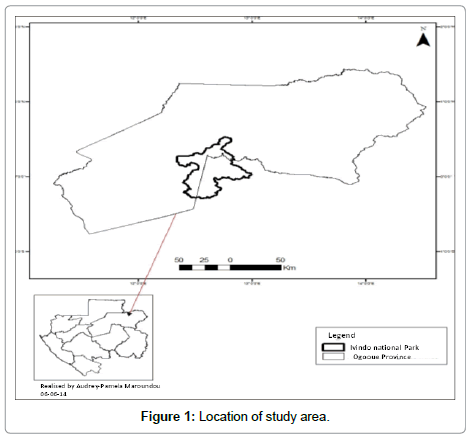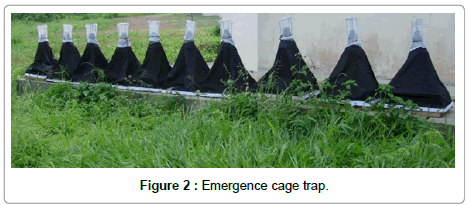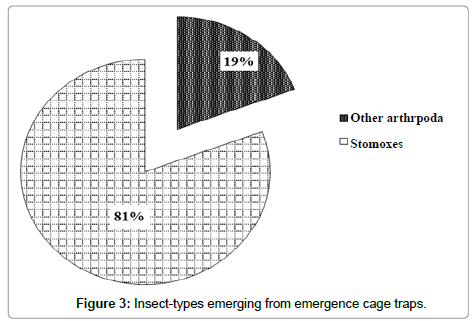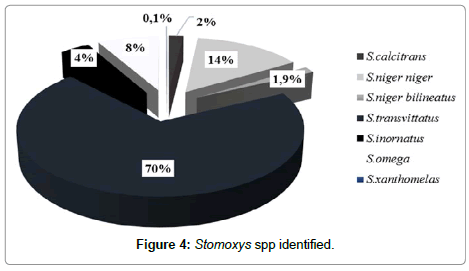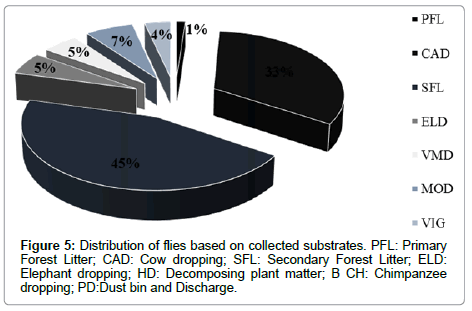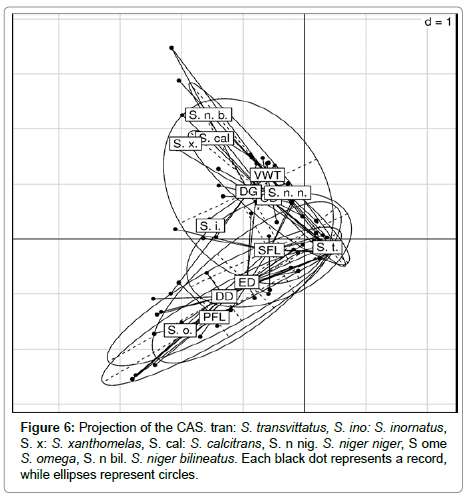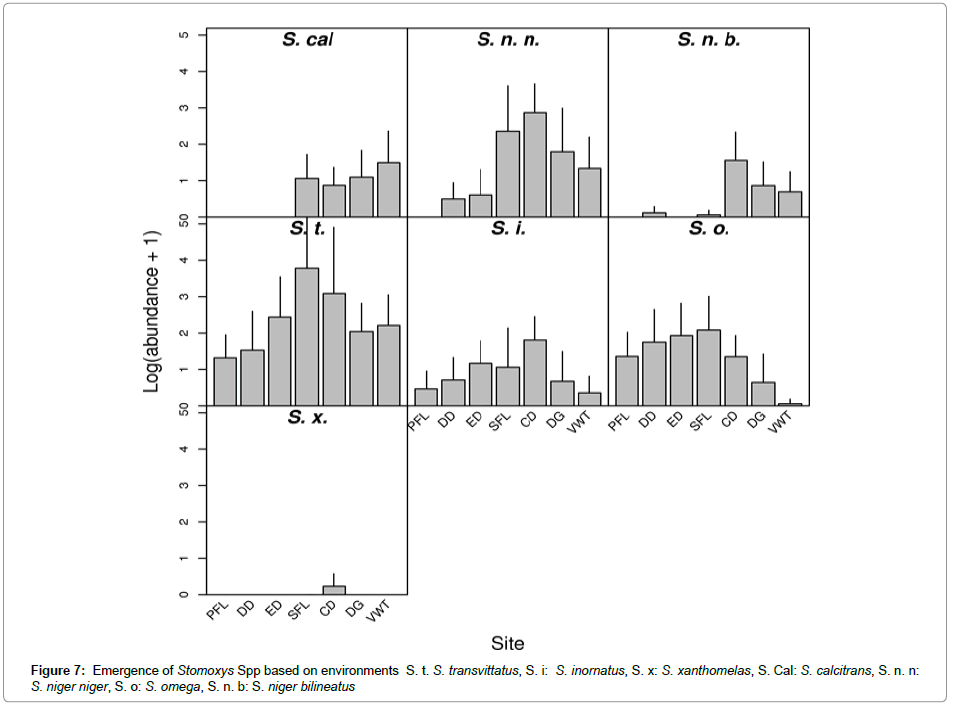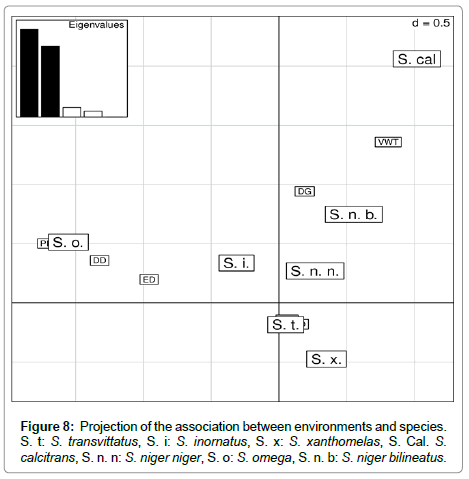Research Article, Vector Biol J Vol: 2 Issue: 1
Breeding Sites of Stomoxys spp (Diptera: Muscidae), a Preliminary Study in the Makokou Region (North-East-Gabon)
Jacques François Mavoungou1,2*, Rodrigue Mintsa Nguema1, Geneviève Lydie Acapovi3, Roland Zinga Koumba1, Franck Mounioko2, Sevidzem Silas Lendzele4, Ingrid Kindzi Bakakas2, Jérémie Gilles5, Gérard Duvallet6, Bertrand M’Batchi2 and Nicolas Picard7
1Institut de Recherche en Ecologie Tropicale (IRET-CENAREST), Libreville, Gabon
2Université des Sciences et Techniques de Masuku (USTM), Franceville, Gabon
3Laboratoire de Zoologie & Biologie Animale, UFR Biosciences, université Felix Houphouet Boiny, Abidjan-Côte d’Ivoire
4Laboratory of Vector-Borne-Infectious Diseases, Unit of Laboratory of Biology and Applied Ecology, Department of Animal Biology, Faculty of Science, University of Dschang, Cameroon
5Institut für Vergleichende Tropenmedizin und Parasitologie, München, Germany
6Université Paul-Valéry Montpellier 3, Centre d’Ecologie Fonctionnelle et Evolutive, UMR 5175, Montpellier, France
7Chercheur associé du CIRAD au CENAREST Cirad, Unité de Recherche B&SEF, BP 4035, Libreville, Gabon
*Corresponding Author: Jacques François Mavoungou
Institut de Recherche en Ecologie Tropicale (IRET), BP 13354, Libreville, Gabon
Tel: +241 733089/35
E-mail: mavoungoujacques@yahoo.fr
Received: April 28, 2017 Accepted: May 05, 2017 Published: May 15, 2017
Citation: Mavoungou JF, Nguema RM, Acapovi GL, Koumba RZ, Mounioko F, et al. (2017) Breeding Sites of Stomoxys spp (Diptera: Muscidae), a Preliminary Study in the Makokou Region (North-East-Gabon). Vector Biol J 2:1. doi: 10.4172/2473-4810.1000115
Abstract
In order to circumscribe the breeding sites of stomoxes in the Makokou region, eight potentially favorable environments were sampled from January to June 2007 in three habitats: primary and secondary forest (natural environments) and the anthropic environment (artificial or disturbed areas). In the primary forest, three types of substrates were collected: litter, elephant dung and Cephalophus droppings. In the secondary forest, two types of substrates: litter and monkey droppings. In villages or cities, three substrates constituting of: decaying plant material, organic waste from garbage in villages and cow dung were also collected. These materials were placed in emergence cages while awaiting the emergence of adult arthropods. In total, 14517 arthropods emerged, including 11726 stomoxes and 2791 other arthropod specimens. Seven Stomoxys spp were observed and included: S. transvittatus with 8221 (70%) emerged individuals, S. niger niger with 1679 (14%) observed individuals. However, S. omega (8%); S. inornatus (4%); S. calcitrans (2%); S. niger bilineatus (1.9%); and finally S. xanthomelas (0.1%) emerged in minor proportions. The results obtained in this study indicate that stomoxes can lay their eggs on several types of substrates hence colonizing many areas
Keywords: Stomoxes; Breeding media; Development; Abundance; Gabon
Introduction
Stable flies (Stomoxys spp.) are insects that feed on blood and are potential vectors of several pathogens [1,2]. Indeed, because of their blood feeding habits, they are a plague due to their direct nuisance (harassment and blood predation), but also by the role they play as potential vectors of various pathogenic agents [3-8]. Moreover, stable flies cause considerable economic losses in stock farms by their direct pathogenic effects. In the USA, economic losses inflicted by stable flies on the livestock industry were evaluated to be between 100 and 400 million dollars [9,10]. Some species of stable flies are described as a limiting factor to milk and meat production, they equally cause severe irritation, blood loss and at times the death of animals in extreme cases [11,12]. These insects are also potential mechanical vectors of pathogens of animal origin such as viruses, equine infectious anemia, Trypanosoma evansi and Besnoitia besnoiti [2]. Stable flies in the Afrotropical region remain poorly understood. Presently, there is little information about the biology and ecology of this group, despite the existence of reports in some areas [13-20]. In addition, majority of available information is based on the cosmopolitan species Stomoxys calcitrans and more recently from S. niger niger Macquart, 1851 [13]. However, stable flies can exist in multiple environments including urban [21-23], rural areas near stables, slaughter houses, cattle markets, dumped waste and occasionally in natural areas such as forests and national parks [24]. Moreover, factors such as temperature, precipitation, physical barriers, habitat and presence of vertebrate hosts are likely to influence their distribution, development and abundance; and consequently the distribution of diseases they transmit to humans and animals [25]. The study of these factors in natural environments is very important in the ecology and epidemiology as they are spatial risk factors for vector-borne diseases [26]. Knowing these factors will guide in the implementation of vector control strategies and also help to locate areas of high transmission potential [1,18,19,26]. In Gabon, much work has already been grounded on the population genetics of stable flies [27], origin of blood meal [24] and detection of pathogenic agents transmitted by these insects (Mounioko [27],). Other studies have revealed the presence of seven species of stable flies in various ecological zones [16-19,24]. These studies seek to know the role of landscape structure on the ecodistribution of populations of stable flies [16-19]. However, few studies have focused on breeding and the identification of the various breeding sites of these insects. The study of habitat of pre-imaginal forms can provide information about the life cycle, population dynamics and the physico-chemical composition of a given area [26]. According to the World Health Organization [28], sustainable management of breeding sites of insect vectors is of paramount importance in vector control and preservation of human health. To collect data on breeding of stable flies, an entomological survey was conducted in three different habitats represented by primary/secondary forests and neighborhoods of the city of Makokou in Gabon. The objective of this study was to identify and characterize potential breeding sites of stomoxines in order to set up strategies for their fight and subsequently the pathogens they transmit.
Materials and Methods
Location and description of study area
The study was conducted in Makokou region in the province of Ogooue Ivindo, North East of Gabon (Figure 1). The climate of this region is hot, humid and equatorial and characterized by a double alternation of rainy and dry seasons [29]. Four seasons exist in this province and can be distinguished as such-short rainy season (from mid-September to mid-December, characterized by fairly frequent thunderstorms sometimes accompanied by tornadoes), short dry season (from mid-December to mid-March which is often marked by clear skies and a few sporadic rains), long rainy season (from mid-March to mid-June, this period is characterized by an increase in precipitation which are most often stormy) and long dry season (from July to August, the negative effect about this period is the sharp decrease in rainfall on vegetation which is also characterized by an almost permanent high cloudiness throughout the season), it was during this period that the lowest temperatures were observed during the year. The annual rainfall is around 1700 mm on average; while the average annual temperature is 24° C, with a minimum of 21.7°C in July and a maximum of 25 °C in April. The annual and daily thermal amplitudes are low (about 3.3 °C). Vegetation consists mainly of primary forest land and floodplain forests. There are also some secondary forest patches resulting from the impact of human activity in the region and can be observed in various places such as roads or borders around the formerly cultivated plots. They are mostly canopy-trees (Musanga cecropioides) and various Anthocleista spp of the family Loganiacae [1]. The fauna is rich and diverse; there are nearly 128 species of mammals, 424 species of birds, 65 species of reptiles and 47 species of amphibians. Some of these species posses nocturnal activity and others diurnal, like most bird species. Nocturnal forest mammals consist of 11 species.
Collection of substrates suitable for the development of stable fly’s larvae
Eight types of suitable substrates for the reproduction of stable flies were collected along a transect from the primary forest in an anthropic environment (Makokou districts) through secondary forest. The primary and secondary forests represented natural environments while the neighborhoods such as Makokou stood for artificial or manmade environments. In the primary forest, three types of substrates were collected: litter (PFL), elephant dropping (ELD) and small African antelope (Cephalophus) dropping (CED). In secondary forest, two types of substrates were collected which consisted of litter (SFL) and Chimpanzee dropping (MOD), while in the neighborhoods of Makokou, three substrates were collected namely: decaying plant matter (VMD), organic waste from garbage in villages (VIG) and cow dropping (CAD). The substrates were collected with a shovel and with a minimum of ground to avoid the presence of soil-dwelling larvae. Collected substrates were placed in plastic bags (polyethylene) labeled with information like place of collection and type of waste. All the collected substrates were transported to the laboratory and distributed in cages.
Breeding method
The emergence cage traps are generally pyramidal in shape (40 cm length x 30 cm width x 40 cm height). Their basal support is tightly surrounded by a wooden frame (50 x 50 cm). This basal support is covered by a black cotton fabric to ensure darkness. At the top of this trap, a funnel-shaped cage is placed and this Roubaud cage is covered with a bag made up of white mosquito net. This device was used to trap the imagos after emergence (Figure 2). An aliquot of 700 g of each substrate was placed in each cage prior to emergence for a total of 12 emergence cages. These cages were installed in a room where the temperature was maintained at 25°C throughout the study, but for the Chimpanzee dropping (from the primary and secondary forest), 6 cages containing 400g each of the substrate were used (Table 1).
| Month (2006) | Source of substrate | Nature of substrate | Number of cages used | Mass of substrate in cages (grams) | ||||
|---|---|---|---|---|---|---|---|---|
| Jan. | Primary forest | Litter (PFL) | 12 | 700 | ||||
| Feb. | Secondary forest | Litter (SFL) | 12 | 700 | ||||
| Mar. | Anthropized milieu | Cow dropping (CAD) | 12 | 700 | ||||
| Apr. | Primary forest | Elephant dropping (ELD) | 12 | 700 | ||||
| May | Anthropized milieu | Decomposing grass (VMD) | 12 | 700 | ||||
| Jun. | Primary forest | Cephalophus dropping (CED) | 12 | 700 | ||||
| Jul. | Secondary forest | Chimpanzee dropping (MOD) | 6 | 400 | ||||
| Aug. | Anthropized milieu | organic waste from garbage (VIG) | 12 | 700 | ||||
Table 1: Data on the implementation of protocol.
The emergence cages were monitored daily for a period of 25 days. The appearance of adult flies (imago) indicated the completion of their developmental cycle and they are attracted to light in the Roubaud cages where they are trapped. They were harvested and preserved in 95 % alcohol prior identification as stomoxes or others. Stomoxys spp were separated from other insects, counted, date noted, species and capture time recorded. The identification of stable flies was made under a dissecting microscope based on the identification key issued by Zumpt [4] and Garros [30].
Data analysis
A correspondence analysis (CA) was conducted to see the structuring of data on the aggregate table containing 84 rows and 7 columns giving plenty of each of the seven species identified in each of the 84 bred. This analysis took into account qualitative parameters such as: species and different surveys. Information relating to media (litter primary forest, cow dung, secondary forest litter, etc.) was not used in this CA. It was rather used after with CA, to classify records. To study the species-repeated relationship, the 84 × contingency table S (where S is the number of species) giving abundance of each species in each repetition and was analyzed using analysis of correspondence (CA) [31]. The type of reproduction media was not included in the CA, but was used after to check whether the orderly nature of replication by CA was compatible with the media type. Based on each species, one-way analysis of variance was performed to test the differences in the abundance of species between breeding substrates. The statistical unit consisted of 84 observations for each species. To address the heterogeneity of the data, abundances were transformed logarithmically before the analysis of variance: the number of individuals x species were replaced by log10 (x + 1). The analysis of variance was completed by a pair-wise comparison test of Newman-Keuls. To study the relationship of media-species, a 7 × contingency table S giving the cumulative abundance of each species in each reproduction medium was analyzed using correspondence analysis. A significant difference was found between the substrates (P < 0, 05). The CA was completed by a χ2- test to show the relationship between species and breeding substrates. All statistical analyses were performed using the R statistical software of version 2.15.0 (R Development Core Team 2012).
Results
Overall abundance of the emerged insects
In the collection cages, the overall adult that emerged was 14517 and consisted of 11726 (81%) stomoxes and 2791 (19%) specimens other than Stomoxys spp (Figure 3).
Stomoxys spp identified
Of the 11726 stomoxines that emerged, seven species were identified with varying abundances. These species consisted of Stomoxys transvittatus, S. niger niger, S. omega, S. inornatus, S. calcitrans, S. xanthomelas and S. niger bilineatus. S. transvittatus was the most abundant species with 8221(70%) individuals. S. niger niger (1679) and S. omega (947) were represented with average rates of 14% and 8% respectively. S. inornatus 463 (4%), S. calcitrans 224 (4%) and S. niger bilineatus 185 (1.9%) were poorly represented. S. xanthomelas (0.1%) was least represented (Figure 4).
A large variation was observed between the number of emergedflies and different substrates. Indeed, the litter of secondary forest (SFL) (5,268 (45%)) and cow dropping (CAD) (3,882 (33%)) were the preferred substrates of stomoxes (Figure 5). Primary forest litter (PFL) was the least productive substrate with only 138 (1%) individuals of stomoxes identified after emergence. Other substrates established a less favorable breeding ground and development of stable flies as seen with an emergence rate of 1%.
CA analysis
The projection of every statement and the illustrations on the first two axes of the CA is shown in Figure 6. Although medium is not used as a variable in the CA, consistency was observed between the structure readings and settings. Indeed, firstly, axis 1 of the CA explains 28.0% of the total inertia, while the second axis explains only 22.6%. Furthermore, axis 2 of the CA can be interpreted as increasing gradient readings from primary forest litter upto trash and debris from the village, through Cephalophus dropping and elephant dropping (Figure 6).
Analysis of variance (ANOVA)
To clarify the results of this first CA, ANOVA abundance (log data) of each species was conducted with a single factor, known as medium (Figure 7). The results obtained for each species were as follows:
S. calcitrans: log-abundance is significantly (F6, 77 = 6.85, p-value <0.001) different between environments. Peak abundance was observed in the trash and debris from village.
S. niger niger: log-abundance was significantly (F6, 77 = 7.41, p-value <0.001) different between environments; this species had peak abundance in cow dropping.
S. niger bilineatus: log-abundance was significantly (F6, 77 = 8.70, p-value <0.001) different between environments; this species also had peak abundance in cow dropping.
S. transvittatus: log-abundance was significantly (F6, 77 = 2.69, p-value = 0.02) different between environments. Peak abundance was noticed in secondary forest litter.
S. inornatus: log-abundance was significantly (F6, 77 = 2.44, p-value = 0.03) different between environments. The peak abundance was recorded with cow dropping
S. omega: log-abundance was significantly (F6, 77 = 4.68, p-value <0.001) different between environments, peak abundance for this species was found in secondary forest litter.
S. xanthomelas: log-abundance, unlike other species, revealed no significant (F6, 77 = 2.2, p-value = 0.052) difference between substrate environments.
CA and the χ2-test
In this second analysis, each medium was represented by 12 readings. After cumulative abundances of each medium were considered, a new contingency table was generated. A CA latter and cumulative abundance of each species in each medium was carried out. The first axis of the CA explains 50.4% of the total inertia, while the second axis explains 40.7%. The projection of 7 environments and 7 species on the first two axes of the CA is shown in Figure 8. This Figure 8 shows associations between environments and species. CA was supplemented by a χ2-test that revealed a significant (χ2 = 4046.7, p-value <0.001) binding between species and environment.
Discussion
The results obtained in this study is preliminary and focused in defining the potential suitable development substrates for the larvae of stable flies in the Makokou region of north east, Gabon. Furthermore, the methodology developed in this work can be used, notably in primary /secondary forests, savannahs and anthropogenic habitats (villages). This present research work reveals that stable flies can lay their eggs on several types of substrates including: litter, elephant dropping, Cephalophus dropping, chimpanzee dropping, decomposing plant material, cow dropping and organic waste from dust bins in villages. These results corroborated with those obtained by Gamal [32], Grimaud [33] which showed that stable flies develop in sites associated with unsanitary conditions, animal waste coupled with organic waste from plant origins. The results obtained in this study have also shown that stable flies can colonize several types of environments such as in primary/secondary forests and man-made environments (villages). These observations are similar to that made from the studies conducted by several authors who showed that stable flies are present in many habitats including primary /secondary forests and anthropic environments [1,13,16,17,34]. Knowledge of biological diversity and risk assessment related to biting flies (stable flies) in human and animal circles are of paramount importance to human health. In this study, seven species of stomoxes previously described in this region were signaled [1,27]. These species were represented by S. calcitrans, S. transvittatus, S. inornatus, S. omega, S. niger niger, S. niger bilineatus and S. xanthomelas. Several types of potentially favorable breeding grounds of these species have thus been identified. Generally, substrates that favoured the emergence of flies are from disturbed environments such as secondary forests and man-made environments. These substrates are represented by secondary forest litter and cow dung from man-made environments. The differences in adult Stomoxys spp emergence in various substrates isolated could be explained by the different micro-climatic conditions prevailing in these substrates which offer a conducive milieu for the development of stable fly larvae. Furthermore, temperature, relative humidity and rate of drying substrates may vary depending on the type of environment. In addition, the litter of secondary forest and cow dropping seem to offer ideal conditions for stable fly larval survival. This finding is similar to that obtained by Nibaruta [35] who showed that diptera are likely to grow in large numbers in cow dropping. These results also support the work of Vaillant [36] who reported that some species of blood-sucking flies prefer to deposit their eggs or larvae on organic material of animal origin. According to the WHO [37], an increment in the number of disease cases transmitted by certain species of biting flies could be due to organic material of animal origin as well as faeces from cattle, providing conditions for the development of eggs and larvae of these insects. These substrates could provide an ideal environment for the development of stable fly larvae and thus a better reason for their blooms in the surveyed environments. Furthermore, data analysis showed that some Stomoxys species were substrate specific. Similarly, the correspondence analysis confirmed this assertion, based on the association between environment and species. Indeed, S. omega, is associated with primary forest litter, Cephalophus dropping and elephant dropping. Considering S. transvittatus and S. inornatus, they are only associated with secondary forest litter. S. niger niger is more frequent in cow dropping and rotting weeds. S. xanthomelas, S. calcitrans and S. niger bilineatus are associated with garbage and village debris (man-made environments). These results could be explained by the fact that each species has its own bio-ecological requirements for instance S. niger niger is a species that is most prevalent in tropical rain forest areas of Africa and in South Sudan farmer-settlement areas [1,4]. Considering S. calcitrans, it is known as a cosmopolitan species often associated with human activities related to livestock [4,13]. S. xanthomelas is present in forest areas [4,24]. S. transvittatus, S. omega and S. inornatus seem to be more subservient to the forest where human density is low and where the floor of this forest is covered with organic material. Microclimate presented by different substrates could therefore play a role in the distribution and abundance of different species of stable flies. Gilles [13,14] showed that temperature had an effect on the rate of development of some species including Stomoxys calcitrans and S. n. niger. Comparing the abundances using ANOVA, it was noted that there were significant differences in the distribution of certain Stomoxys species depending on the substrate. S. xanthomelas is the least abundant species (seven occurrences only) while S. transvittatus was most abundant (with 8,189 occurrences). Similarly, substrates such as secondary forest litter and cow dropping were those that manifested high abundance of stable flies with 5,268 and 3,883 proportions respectively. These environments appear to be richer in minerals that favor the larval development of stable flies than other substrates like primary forest litter. It is not surprising with the unusual peaks of abundance of many species. S. calcitrans peak was highest in trash and debris from village. Considering S. niger niger, S. niger bilineatus and S. inornatus, their peak abundances occurred in cow dropping. S. transvittatus and S. omega, presented their peak abundances in secondary forest litter. S. xanthomelas did not present significant differences between the sampled environments.
The second CA, associated with the χ2-test enabled us to show clearly that axis 1 thereof include exactly the same gradient circles on axis 2 of first CA, with one end standing for un-disturbed environment (primary forest litter, elephant dropping and Cephalophus dropping and the other end anthropogenic environments (garbage and debris village and decaying grass) and between the two secondary areas (secondary forest litter and cow dropping). Moreover, relying on the contributions of the χ2-test, we can identify some definitive associations. Indeed, S. omega is specifically associated with primary forest litter, the duiker (genus: Cephalophus) dropping and elephant dropping. This is consistent with the first CA. However, this same species has peak abundance in litter of secondary forest. The peak abundance could simply result from the fact that the abundance is globally (all species) higher in secondary forest litter, which does not reflect a specific association. S. niger niger is specifically associated with decaying plant material and is consistent with the first CA. This species showed peak abundance in cow dropping and could be explained by the fact that the abundance of stable flies is generally very high in cow dung. S. calcitrans is specifically associated with village trash and debris. Moreover it is a cosmopolitan species that can grow on various substrates and environments. Considering S. inornatus, S. transvittatus, S. xanthomelas and S. niger bilineatus, they do not show a clearly defined media preference.
Conclusion
This study is a valuable contribution to identifying potentially suitable substrates for the development of stable fly larvae. The identified substrates were represented by litter, elephant dropping, Cephalophus dropping, chimpanzee dropping, decaying plant material, organic waste from garbage in villages and cow dropping. Furthermore, there is substrate preference of these species and this depends on the type of substrate for example S. omega is specifically associated with the litter of primary and secondary forest, Cephalophus and elephant droppings. S. niger niger is associated with decaying plant material and cow dropping. S. calcitrans is associated with village trash and debris. S. inornatus, S. transvittatus, S. xanthomelas and S. niger bilineatus do not have a clearly defined preferred environment. It is interesting to know that each species presented a maximum abundance in a particular environment. In cages, S. calcitrans peak abundance was noticed in trash and debris from village. S. niger niger, S. niger bilineatus and S inornatus were most abundant in cow dropping. Based on S. transvittatus and S. omega, they presented the highest and effective development in litter from secondary forest. S. xanthomelas presented no particular abundance with substrate. Biostatistical analyses revealed a net filiation between the different species described and selected potential breeding site. The distribution and abundance of these blood-sucking insects varied with environment. This reflects the openness, flora and fauna composition of the environment.
A thorough study of each substrate including factors such as: humidity, percentage of organic matter (plant and animal), particle size of the ground and monitoring of annual variations of these substrates is essential in the determination of the ecological requirements for larval development of each kind of stable fly.
Acknowledgements
This work received funding from the European Union through the European Development Fund Project 8 ACP GA 009 (PSVAP-Component II Makokou, CNPN-MESRIT-U.E./IRETCIFOR). We would like to thank Philippe Hecketsweiller, Paul Posso, Robert Nasi and Charles Doumenge for their advice and assistance. Thanks to Nicolas Yao Emba, Joseph Okouyi.
References
- Mavoungou JF (2007) Ecologie et rôle vecteur des stomoxes (Diptera: Muscidae) au Gabon. Thèse de doctorat. Université Montpellier III PAUL VALERY 137.
- Baldacchino F, Muenworn V, Desquesnes M, Desoli F, Charoenviriyaphap T, et al. (2013) Transmission of pathogens by Stomoxys flies (Diptera, Muscidae): A review. Parasite 26:13.
- Leclercq M (1967) Contribution à l’étude des Trypetidae (Diptera) paléarctiques et de leurs relations avec les végétaux. Bulletin de Recherche Agronomique de Gembloux 2: 64-105.
- Zumpt F (1973) The Stomoxyinae biting flies of the world. Taxonomy, biology, economic Importance and control measures. Gustav Fischer Verlag, Stuttgart.
- Mihok S, Kangethe EK, Kamau GK (1995) Trials of Traps and Attractants for Stomoxys spp. (Diptera, Muscidae). J Med Entomol 32: 283-289.
- D'amico F, Gouteux JP, Le Gall F, Cuisance D (1996) Are stable flies (Diptera: Stomoxyinae) vectors of Trypanosoma vivax in the Central African Republic. Vet Res 27: 161-170.
- Foil LD, Gorham JR (2000) Mechanical transmission of disease agents by arthropods. In Medical Entomology. Kluwer Academic Publishers, Dordrecht, Netherlands.
- Campbell JB, Skoda SR, Berkerile DR, Boxler DJ, Thomas GD, et al. (2001) Effects of stable flies (Diptera: Muscidae) on weight gains of grazing yearling cattle. J Econs Entomol 94: 780-783.
- Kunz SE, Monty J (1976) Biology and ecology of Stomoxys nigra Macquart and Stomoxys calcitrans (L.) (Diptera, Muscidae) in Mauritius. Bulletin Entomol Res 66: 745- 755.
- Foil LD, Hogsette JA (1994) Biology and control of tabanids, stable flies and horn flies. Rev Sci Tech 13: 1125-1158.
- Monty J (1972) A review of the stable fly problem in Mauritius. La Revue Agricole et Sucriere de l'ile Maurice 51:13-29.
- Kunz SE, Monty J (1976) Biology and ecology of Stomoxys nigra Macquart and Stomoxys calcitrans (L.) (Diptera: Muscidae) in Mauritius. Bull Entomol Res 66: 745-755.
- Gilles J, Litrico I, Duvallet G (2005) Microsatellite loci in the stable fly, Stomoxys niger niger (Diptera : Muscidae) on La Réunion Island. Mol Ecol Notes 5: 93-95.
- Gilles J, David JF, Duvallet G (2005) Temperature effects on development and survival of two stable flies, Stomoxys calcitrans and Stomoxys niger (Diptera: Muscidae), in La Réunion Island. J Med Entomol 42: 260-265.
- Gilles J, David JF, Duvallet G (2005) Effects of temperature on the rate of increase of two stable flies from La Réunion island, Stomoxys calcitrans and Stomoxys niger niger (Diptera: Muscidae). J Med Entomol 42: 959-965.
- Zinga-Koumba RC, Acapovi-Yao GL, Mavoungou JF, Tongue KL, Mbang-Nguema OA,et al. (2013) Influence de la saison sur l’écodistribution des glossines, tabanides, stomoxes du Baï de Momba Makokou, Gabon. Agronomie Africaine 25: 149-158.
- Zinga-Koumba RC, Bouyer J, Mavoungou JF, Acapovi-Yao GL, Kohagne TL, et al. (2013) Evaluation de la diversité des diptères hématophages dans une clairière marécageuse du Gabon à l’aide des pièges Vavoua et Nzi. Rev Elev Méd Vét Pays Trop 66: 91-96.
- Zinga-Koumba CR, Mbang-Nguema OA, Kohagne TL, Acapovi-Yao GL, Obame OKP, et al. (2014) Contribution à l’évaluation de la diversité des vecteurs biologiques de la Trypanosomose Humaine Africaine et de leur activité journalière dans le Parc National de l’Ivindo (Nord-est Gabon). J Appl Biosci 80:7060-7070.
- Zinga-Koumba CR, Mbang-Nguema OA, Mavoungou JF, Obame Ondo KP (2014). Ecodistribution des tabanidés, glossines et stomoxes le long d’un transect forêt Primaire-village au Gabon. Int J Biol Chem Sci 8: 167-181.
- Sevidzem SL, Mamoudou A, Acapovi-Yao GL, Achiri M, Tchuinkam T, et al. (2016) First inventory of non-biting and biting muscids of North Cameroon. Int Res J Biol Sci 5: 12-20.
- Campbell JB, Berry IL, Boxler DJ, Clanton DC, Deutscher GH (1987) Effects of stable fly (Diptera: Muscidae) on weight gain and feed efficiency of feedlot cattle. J Econs Entomol 80: 117-119
- Campbell JB, Skoda SR, Berkerile DR, Boxler DJ, Thomas GD, et al. (2001) Effects of stable flies (Diptera: Muscidae) on weight gains of grazing yearling cattle. J Econs Entomol 94: 780-783.
- Rouet D (2011) Dynamique des populations de Stomoxys calcitrans dans un site urbain, Ecole Nationale Vétérinaire de Toulouse. Toulouse 3:116.
- Mavoungou JF, Jay-Robert P, Gilles J, Atsame Edda A, Gerard D (2008) Ecologie des stomoxes (Diptera : Muscidae) au Gabon I remier inventaire dans différentes zones écologiques. Parasite 15: 27-34.
- Young D, Arias J (1992) Phlebotomine sand flies in the Americas. DC Pan American Health Organization. Washington, USA.
- Boussaa S, Ali B (2014) Identification et caractéristique des gîtes larvaires de phlebotomes (Diptera : Psychodidae) à Marrakech (Maroc). Faunistic Entomol 67: 93-101.
- Dsouli N (2009) Contribution à la phylogénie du genre Stomoxys (Diptera, Muscidae) et à la phylogéographie de Stomoxys calcitrans (L. 1758). Université Montpellier III- PAUL VALERY 1.
- WHO (2002) Urbanization: an increasing risk factor for leishmaniasis. Weekly Epidemiological Record 77: 365-372
- Vande WJP (2006) Les 13 parcs nationaux du Gabon. Ivindo & Mwagna. Eaux noires, forêts vierges et baïs. Wildlife Conservation Society, Libreville, Gabon.
- Garros C, Gilles J, Duvallet G (2004) Un nouveau caractère morphologique pour distinguer Stomoxys calcitrans et S. niger (Diptera: Muscidae). Comparaison de populations de l’île de la Réunion. Parasite 11: 329-332.
- Jongman RHG, Ter Braak CJF, VanTongeren OFR (1987) Data analysis in community and landscape ecology. Cambridge University Press, Cambridge, UK
- Gamal-Eddin FM (1963) Experimental studies on the development stages of two blood-sucking flies (Stomoxys calitrans, Lin. And S. sitiens, Rond.) In Egypt (Diptera: Stomoxydinae). J Arab Vet Med Assoc 23: 309-338.
- Grimaud Y (2013) Les stomoxes (Diptera : Muscidae) à l’Île de La Réunion : Biologie, écologie et moyens de lutte. GDS Réunion, Août. 1-8.
- Bitome EPY, Moncharmont FX, Mavoungou JF, Mba OR, Duvallet G, et al. (2015) Distribution and abundance of hematophagous flies (Glossinidae, Stomoxys, and Tabanidae) in two national parks of Gabon. Parasite 22: 25.
- Nibaruta G (1982) Etude écologique des diptères associés aux excréments de la vache domestique en milieu tempéré. Revue d’Ecologie Biologie Sol 19: 203-223.
- Vaillant F (1970) The ecological requirements of Diptera larvae Psychodidae. Bulletin de la société zoologique de France 95: 305-315.
- WHO (2002) The world health report (2002) Reducing Risks, Promoting Healthy Life. Geneva, Switzerland.
 Spanish
Spanish  Chinese
Chinese  Russian
Russian  German
German  French
French  Japanese
Japanese  Portuguese
Portuguese  Hindi
Hindi 